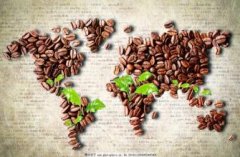A brief introduction to the treatment method of grinding degree and baking degree of Brazilian yellow bourbon coffee beans

In addition, the biggest thing that iron pickup and bourbon have in common is that they both need the protection of shade trees. if there is no shade tree to help it block the sun, it is not only not conducive to its growth, but also greatly reduces the flavor of coffee beans.
In Brazil, because the planting area of coffee is too large and the degree of mechanized production is relatively high, people often harvest ripe and green fruits together, and there is usually no sorting process. Sometimes coffee fruit is mixed with coffee branches and leaves. Not only that, Brazilian coffee beans are sun-dried, and farmers put coffee beans of different maturity together and expose them in the sun, so that the beans are mixed with soil and various impurities in the first place. sometimes overripe and rotten coffee fruits also affect the flavor of coffee beans. The bourbon in Bourbon Santos comes from the Bourbon Indian Arabica coffee tree. The island of Bourbon, now known as Reunion, was once a thriving place for Arabica coffee. Arabik coffee trees grown on the island were introduced around the world, and Brazil's Bourbon Santos is their descendant. Sandoz comes from the port of Sandoz, a port in the Atlantic Ocean in southeastern Brazil. Among the coffee exported from Santos port, there are Brazilian coffee from different producing areas, and the quality is more guaranteed from Sao Paulo, Parana and southern Minas Gerais, among which Minas Gerais has the best quality.
Brazil has also proved to be able to produce gourmet coffee and small quantities of coffee, and the local boutique coffee can not only be provided by small-scale coffee farmers. The main coffee producing areas in Brazil are Sulde Minas South Minas, Matas de Minas Minas South East Mountain Forest, Cerrado Hirado, the north-central mausoleum of Chapadas de Minas Minas, Mogiana, Paran á Parana and Bahia Bachia. There are both traditional varieties and variants, such as Bourbon, Mondo Novo Mondonovo, Icat ú Ikatu, Kaduai, Iapar, cultivatedcard Taiyi.
Finally, it is better to choose between 1 minute and 15-20 seconds after the end of the explosion. Taste with obvious sweetness, but not so boring sweet, the background with a hint of lemon aroma, this aroma is more prominent in the wet fragrance stage, the latter part of the performance has an obvious taste of dark chocolate, the overall feeling is more round, while reflecting the characteristics of Brazil as a whole, the size of lively coffee beans is 1718 mesh, the color is clear and moist, very fresh. Coffee beans are treated with pulped natural and dried in the sun, that is, the coffee is mechanically peeled, leaving the seeds and pulp of the coffee, and then sun-dried. The harvest season is from March to June every year, and this batch of beans is the latest batch of beans.
Unlike in the past, Brazil's economy is now less dependent on coffee, which accounts for only 8% to 10% of GDP. Before World War II, Brazil accounted for 50% or more of the world's coffee production, and now it is close to 30%. But the country's impact on the world coffee, especially on coffee prices, is very important. for example, two frost disasters in 1994 caused a sharp rise in global coffee prices.
Unlike in the past, Brazil's economy is now less dependent on coffee, which accounts for only 8% to 10% of GDP. Before World War II, Brazil accounted for 50% or more of the world's coffee production, and now it is close to 30%. But the country's impact on the world's coffee, especially on coffee prices, is significant. For example, two frost disasters in 1994 caused a sharp rise in global coffee prices.
Since the introduction of coffee trees from French Guiana (Guyana) in 1720, coffee production has gradually become a science. Before 1990, the Brazilian government carried out strict monitoring of the coffee industry, with both strict intervention and price protection measures, and the state has been implementing minimum price protection measures for farmers, resulting in coffee overproduction. Before World War II, the remaining stock reached 78 million bags, which had to be burned by fire or thrown into the water to destroy.
Since the opening of the free market in 1990, the original Brazilian Coffee Authority (IBC) has been replaced by the National Economic Association, the country's non-investment administrative body, which pursues a policy of non-intervention and allows producers to negotiate directly with exporters. The business activities of exporters are supervised by the government legislation, and the relevant departments register legitimate exporters.
Taste characteristics: sweet and smooth fruit sweetness, obvious nutty flavor, balanced and supple acidity, weak and clean bitterness, rich chocolate aroma and nutty flavor, bright and fresh taste.
Recommended brewing equipment: French pressure, hand flushing, siphon
One day R boutique coffee manor is put forward by senior coffee practitioner Wen Coffee, and jointly with high-quality and multi-land producing areas, experienced farmers jointly establish a boutique coffee experimental base, after a long period of training, trial planting and breeding, select high-quality coffee and adjust measures to local conditions; finally get the unique regional flavor garden boutique coffee beans.
Generally speaking, the price of yellow bourbon is a little too high, but its unique sweetness and richness are much better than the new world varieties or red bourbon varieties commonly used in Brazil. Especially in the throat rhyme part, you can feel a warm cashew nut throat rhyme.
Producing area: Syrador
Variety: yellow bourbon
Treatment: insolation
Flavor: light citrus fruit aromas, rich cashew nut aromas, chocolate sweet aromas
Palate: sweet, soft and sour, thick and sweet on the palate
Default baking degree: medium baking
Bourbon
"Bourbon" bourbon is an ancient and excellent variety juxtaposed with iron pickup, and some botanists believe that bourbon is an early variety of iron pickup after it was transplanted to Yemen.
Bourbon is almost all round beans, beans are a little smaller than tin card, ripening later, but the yield is 30% more than tin card. It is suitable for growing above 1200 meters above sea level, and its flavor is obviously more prominent than those below 1000 meters, but bourbon has a disadvantage that it will rest for a year as a result. Round bourbon is full of vitality, and its resistance to rust leaf disease is better than that of iron pickup, but its flavor is as good as it, or even better.
In 1810, some of the round beans in Bourbon Island mutated into pointed beans, which is known as the "pointed bourbon". It is characterized by a caffeine content of only half, low output, weak physique, and extremely rare, just like a weak aristocratic teenager.
- Prev

A brief introduction to the origin, development, history and culture of high-quality coffee bourbon beans
In the case of the Queen's Manor, the environmental protection is quite thorough. Because of the high terrain and non-plain terrain, it is impossible to use machines to harvest, and the fruits can be harvested completely by hand. And plant low-yield and high-quality bourbon species, as the essence of high-quality Brazilian coffee on behalf of the manor! This batch of Queen's Manor (Fazenda Rainha) belongs to the Carvalho Dias family, and the estate has been for Pakistan for more than 116 years.
- Next

A brief introduction to the transaction Price of Fine Coffee Yellow bourbon Coffee Variety planting Market
Brazil yellow bourbon coffee yellow bourbon itself is a variety of bourbon species, the peel is yellow, Brazil COE competition over the years many times are yellow bourbon leader, charming flavor areas: Syrador varieties: yellow bourbon treatment: sun flavor: light citrus fruit, rich cashew nutty, chocolate sweet taste: sweet and mild soft fruit acid, thick and sweet mouth
Related
- Detailed explanation of Jadeite planting Land in Panamanian Jadeite Manor introduction to the grading system of Jadeite competitive bidding, Red bid, Green bid and Rose Summer
- Story of Coffee planting in Brenka region of Costa Rica Stonehenge Manor anaerobic heavy honey treatment of flavor mouth
- What's on the barrel of Blue Mountain Coffee beans?
- Can American coffee also pull flowers? How to use hot American style to pull out a good-looking pattern?
- Can you make a cold extract with coffee beans? What is the right proportion for cold-extracted coffee formula?
- Indonesian PWN Gold Mandrine Coffee Origin Features Flavor How to Chong? Mandolin coffee is American.
- A brief introduction to the flavor characteristics of Brazilian yellow bourbon coffee beans
- What is the effect of different water quality on the flavor of cold-extracted coffee? What kind of water is best for brewing coffee?
- Why do you think of Rose Summer whenever you mention Panamanian coffee?
- Introduction to the characteristics of authentic blue mountain coffee bean producing areas? What is the CIB Coffee Authority in Jamaica?

